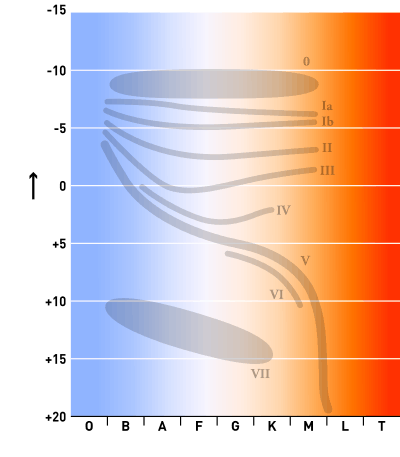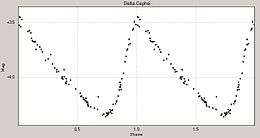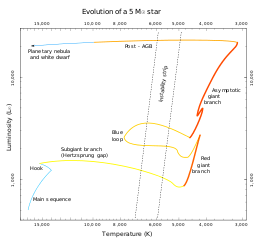Yellow supergiant

A yellow supergiant (YSG) is a supergiant star, generally of spectral type F or G. They are stars that have evolved away from the main sequence, expanding and becoming more luminous.
Yellow supergiants are smaller than red supergiants and less common, examples visible at naked eye including Canopus and Polaris. Many of them are variable stars, mostly pulsating Cepheids such as δ Cephei itself.
Spectrum
Yellow supergiants generally have spectral types of F and G, although sometimes late A or early K stars are included.[1][2][3] These spectral types are characterised by hydrogen lines that are very strong in class A, weakening through F and G until they are very weak or absent in class K. Calcium H and K lines are present in late A spectra, but stronger in class F, and strongest in class G, before weakening again in cooler stars. Lines of ionised metals are strong in class A, weaker in class F and G, and absent from cooler stars. In class G, neutral metal lines are also found, along with CH molecular bands.[4]
Supergiants are identified in the MK system by luminosities classes Ia and Ib, with intermediates such as Iab and Ia/ab sometimes being used. These luminosity classes are assigned using spectral lines that are sensitive to luminosity. Historically, the Ca H and K line strengths have been used for yellow stars, as well as the strengths of various metal lines.[5] The neutral oxygen lines, such as the 777.3 nm triplet, have also been used since they are extremely sensitive to luminosity across a wide range of spectral types.[6] Modern atmospheric models can accurately match all the spectral line strengths and profiles to give a spectral classification, or even skip straight to the physical parameters of the star, but in practice luminosity classes are still usually assigned by comparison against standard stars.[4]
Some yellow supergiant spectral standard stars:[7]
- F0 Ib: α Leporis
- F2 Ib: 89 Herculis
- F5 Ib: α Persei
- F8 Ia: δ Canis Majoris
- G0 Ib: μ Persei
- G2 Ib: α Aquarii
- G5 Ib: 9 Pegasi
- G8 Ib: ε Geminorum
Properties
Yellow supergiants have a narrow range of temperatures corresponding to their spectral types, from about 4,000 K to 7,000 K.[9] Their luminosities range from about 1,000 L☉ upwards, with the most luminous stars exceeding 100,000 L☉. The high luminosities indicate that they are much larger than the sun, from about 30 R☉ to several hundred R☉.[10]
The masses of yellow supergiants vary greatly, from less than the sun for stars such as W Virginis to 20 M☉ or more (e.g. V810 Centauri). Corresponding surface gravities (log(g) cgs) are around 1-2 for high-mass supergiants, but can be as low as 0 for low-mass supergiants.[9][11]
Yellow supergiants are rare stars, much less common than red supergiants and main sequence stars. In M31, 16 yellow supergiants were found that were likely to have evolved from around 25,000 class O stars.[12]
Variability

Many yellow supergiants are in a region of the HR diagram known as the instability strip because their temperatures and luminosities cause them to be dynamically unstable. Most yellow supergiants observed in the instability strip are Cepheid variables, named for δ Cephei, which pulsate with well-defined periods that are related to their luminosities. This means they can be used as standard candles for determining the distance of stars knowing only their period of variability. Cepheids with longer periods are cooler and more luminous.[13]
Two distinct types of Cepheid variable have been identified, which have different period-luminosity relationships: Classical Cepheid variables are young massive population I stars; type II Cepheids are older population II stars with low masses, including W Virginis variables, BL Herculis variables and RV Tauri variables. The Classical Cepheids are more luminous than the type II Cepheids with the same period.[14]
R Coronae Borealis variables are often yellow supergiants, but their variability is produced by a different mechanism from the Cepheids. At irregular intervals, they become obscured by dust condensation around the star and their brightness drops dramatically.[15]
Evolution

Supergiants are all stars that have evolved away from the main sequence after exhausting the hydrogen in their cores. Yellow supergiants are a heterogeneous group of stars crossing the HR diagram at various different stages of their evolution.
Stars more massive than 8-12 M☉ spend a few million years on the main sequence as class O and early B stars until the hydrogen in their cores becomes depleted. Then they expand and cool to become supergiants. They spend only a few thousand years as a yellow supergiant while cooling to become a red supergiant, then one to four million years as a red supergiant. Such massive stars make up less than 1% of all stars. Combined with the relative lifetime of the yellow supergiant phase, this explains the rarity of these stars.[16]
Some red supergiants will perform a blue loop, temporarily heating up and becoming yellow or even blue supergiants before cooling again. Stellar models show that blue loops are extremely sensitive to the chemical makeup of the star and to assumptions of the models themselves, but they are most likely for stars at the low end of the red supergiant mass range. While cooling for the first time or when performing a sufficiently extended blue loop, yellow supergiants will cross the instability strip and pulsate as Classical Cepheid variables with periods around ten days and longer.[17][18]
Intermediate mass stars do not become red supergiants when they leave the main sequence. Instead they cool along the subgiant branch until they reach the red giant branch. Stars more massive than about 2 M☉ have a sufficiently large helium core that it begins fusion before becoming degenerate. These stars will perform a blue loop, and for masses between about 5 M☉ and 12 M☉, the blue loop can extend to F and G spectral types at luminosities around 1,000 L☉. These stars may develop supergiant luminosity classes, especially if they are pulsating. When these stars cross the instability strip they will pulsate as short period Cepheids. Blue loops in these stars can last for around 10 million years, so this type of yellow supergiant is more common than the more luminous types.[19][20]
Stars with masses similar to the sun develop degenerate helium cores after they leave the main sequence and ascend to the tip of the red giant branch where they ignite helium in a flash. They then fuse core helium on the horizontal branch with luminosities too low to be considered supergiants. Stars leaving the blue half of the horizontal branch towards the asymptotic giant branch (AGB) pass through the yellow region of the HR diagram and will pulsate as BL Herculis variables. Such stars may be given a supergiant luminosity class due to their low masses and pulsation. On the AGB, thermal pulses from the helium fusing shell may cause a blue loop across the instability strip. Such stars will pulsate as W Virginis variables and again may be classified as relatively low luminosity yellow supergiants.[14]
When the hydrogen-fusing shell in low and intermediate mass stars on the AGB nears the surface of the star, the cool outer layers are rapidly lost, which causes the star to heat up, eventually becoming a white dwarf. These stars have masses lower than the sun, but luminosities that can be 10,000 L☉ or higher, so they will become yellow supergiants for a short time. Post-AGB stars are believed to pulsate as RV Tauri variables when they cross the instability strip.[21]
The evolutionary status of yellow supergiant R Coronae Borealis variables is unclear. They may be post-AGB stars reignited by a late helium shell flash, or they could be formed from white dwarf mergers.[22]
It is not expected that yellow supergiants should explode as a supernova before reaching the red supergiant stage, but the cores of some post-red supergiant yellow supergiants might collapse and trigger a supernova. A handful of supernovae have been associated with apparent yellow supergiant progenitors that are not luminous enough to be post-red supergiants. If these are confirmed then an explanation must be found for how a star of moderate mass still with a helium core would cause a core-collapse supernova. The obvious candidate in such cases is always some form of binary interaction.[23]
Yellow hypergiants
Particularly luminous and unstable yellow supergiants are often grouped into a separate class of stars called the yellow hypergiants. These are mostly thought to be post-red supergiant stars, very massive stars that have lost a considerable portion of their outer layers and are now evolving towards becoming blue supergiants and Wolf-Rayet stars.[24]
References
- ↑ Chiosi, Cesare; Maeder, André (1986). "The Evolution of Massive Stars with Mass Loss". Annual Review of Astronomy and Astrophysics. 24: 329. Bibcode:1986ARA&A..24..329C. doi:10.1146/annurev.aa.24.090186.001553.
- ↑ Giridhar, S.; Ferro, A.; Parrao, L. (1997). "Elemental Abundances and Atmospheric Parameters of Seven F-G Supergiants". Publications of the Astronomical Society of the Pacific. 109: 1077. Bibcode:1997PASP..109.1077G. doi:10.1086/133978.
- ↑ Drout, Maria R.; Massey, Philip; Meynet, Georges (2012). "The Yellow and Red Supergiants of M33". The Astrophysical Journal. 750 (2): 97. arXiv:1203.0247
 . Bibcode:2012ApJ...750...97D. doi:10.1088/0004-637X/750/2/97.
. Bibcode:2012ApJ...750...97D. doi:10.1088/0004-637X/750/2/97. - 1 2 Gray, Richard O.; Corbally, Christopher (2009). Stellar Spectral Classification. Stellar Spectral Classification by Richard O. Gray and Christopher J. Corbally. Princeton University Press. Bibcode:2009ssc..book.....G.
- ↑ Morgan, William Wilson; Keenan, Philip Childs; Kellman, Edith (1943). "An atlas of stellar spectra, with an outline of spectral classification". Chicago. Bibcode:1943assw.book.....M.
- ↑ Faraggiana, R.; Gerbaldi, M.; Van't Veer, C.; Floquet, M. (1988). "Behaviour of O I triplet Lambda-7773". Astronomy and Astrophysics. 201: 259. Bibcode:1988A&A...201..259F.
- ↑ Garcia, B. (1989). "A list of MK standard stars". Bulletin d'Information du Centre de Donnees Stellaires. 36: 27. Bibcode:1989BICDS..36...27G.
- ↑ Figer, Donald F.; MacKenty, John W.; Robberto, Massimo; Smith, Kester; Najarro, Francisco; Kudritzki, Rolf P.; Herrero, Artemio (2006). "Discovery of an Extraordinarily Massive Cluster of Red Supergiants". The Astrophysical Journal. 643 (2): 1166. arXiv:astro-ph/0602146
 . Bibcode:2006ApJ...643.1166F. doi:10.1086/503275.
. Bibcode:2006ApJ...643.1166F. doi:10.1086/503275. - 1 2 Parsons, S. B. (1971). "Effective temperatures, intrinsic colours, and surface gravities of yellow supergiants and cepheids". Monthly Notices of the Royal Astronomical Society. 152: 121. Bibcode:1971MNRAS.152..121P. doi:10.1093/mnras/152.1.121.
- ↑ Burki, G. (1978). "The semi-period-luminosity-color relation for supergiant stars". Astronomy and Astrophysics. 65: 357. Bibcode:1978A&A....65..357B.
- ↑ Gonzalez, Guillermo; Lambert, David L.; Giridhar, Sunetra (1997). "Abundance Analyses of the Field RV Tauri Variables: EP Lyrae, DY Orionis, AR Puppis, and R Sagittae". The Astrophysical Journal. 479: 427. Bibcode:1997ApJ...479..427G. doi:10.1086/303852.
- ↑ Drout, Maria R.; Massey, Philip; Meynet, Georges; Tokarz, Susan; Caldwell, Nelson (2009). "Yellow Supergiants in the Andromeda Galaxy (M31)". The Astrophysical Journal. 703: 441. arXiv:0907.5471
 . Bibcode:2009ApJ...703..441D. doi:10.1088/0004-637X/703/1/441.
. Bibcode:2009ApJ...703..441D. doi:10.1088/0004-637X/703/1/441. - ↑ Majaess, D. J.; Turner, D. G.; Lane, D. J. (2009). "Characteristics of the Galaxy according to Cepheids". Monthly Notices of the Royal Astronomical Society. 398: 263. arXiv:0903.4206
 . Bibcode:2009MNRAS.398..263M. doi:10.1111/j.1365-2966.2009.15096.x.
. Bibcode:2009MNRAS.398..263M. doi:10.1111/j.1365-2966.2009.15096.x. - 1 2 Wallerstein, G.; Cox, A. N. (1984). "The Population II Cepheids". Astronomical Society of the Pacific. 96: 677. Bibcode:1984PASP...96..677W. doi:10.1086/131406.
- ↑ Asplund, M.; Gustafsson, B.; Lambert, D. L.; Rao, N. K. (2000). "The R Coronae Borealis stars - atmospheres and abundances". Astronomy and Astrophysics. 353: 287. Bibcode:2000A&A...353..287A.
- ↑ Meynet, G.; Maeder, A. (2000). "Stellar evolution with rotation. V. Changes in all the outputs of massive star models". Astronomy and Astrophysics. 361: 101. arXiv:astro-ph/0006404
 . Bibcode:2000A&A...361..101M.
. Bibcode:2000A&A...361..101M. - ↑ Meynet, Georges; Georgy, Cyril; Hirschi, Raphael; Maeder, André; Massey, Phil; Przybilla, Norbert; Nieva, M.-Fernanda (2011). "Red Supergiants, Luminous Blue Variables and Wolf-Rayet stars: The single massive star perspective". Société Royale des Sciences de Liège. 80: 266. arXiv:1101.5873
 . Bibcode:2011BSRSL..80..266M.
. Bibcode:2011BSRSL..80..266M. - ↑ Meynet, Georges; Ekstrom, Sylvia; Maeder, André; Eggenberger, Patrick; Saio, Hideyuki; Chomienne, Vincent; Haemmerlé, Lionel (2013). "Models of Rotating Massive Stars: Impacts of Various Prescriptions". Studying Stellar Rotation and Convection. Studying Stellar Rotation and Convection. Lecture Notes in Physics. 865. p. 3. arXiv:1301.2487v1
 . Bibcode:2013LNP...865....3M. doi:10.1007/978-3-642-33380-4_1. ISBN 978-3-642-33379-8.
. Bibcode:2013LNP...865....3M. doi:10.1007/978-3-642-33380-4_1. ISBN 978-3-642-33379-8. - ↑ Pols, Onno R.; Schröder, Klaus-Peter; Hurley, Jarrod R.; Tout, Christopher A.; Eggleton, Peter P. (1998). "Stellar evolution models for Z = 0.0001 to 0.03". Monthly Notices of the Royal Astronomical Society. 298 (2): 525. Bibcode:1998MNRAS.298..525P. doi:10.1046/j.1365-8711.1998.01658.x.
- ↑ Girardi, L.; Bressan, A.; Bertelli, G.; Chiosi, C. (2000). "Evolutionary tracks and isochrones for low- and intermediate-mass stars: From 0.15 to 7 Msun, and from Z=0.0004 to 0.03". Astronomy and Astrophysics Supplement. 141 (3): 371. arXiv:astro-ph/9910164
 . Bibcode:2000A&AS..141..371G. doi:10.1051/aas:2000126.
. Bibcode:2000A&AS..141..371G. doi:10.1051/aas:2000126. - ↑ Van Winckel, Hans (2003). "Post-AGB Stars". Annual Review of Astronomy &Astrophysics. 41: 391. Bibcode:2003ARA&A..41..391V. doi:10.1146/annurev.astro.41.071601.170018.
- ↑ Clayton, Geoffrey C.; Geballe, T. R.; Herwig, Falk; Fryer, Christopher; Asplund, Martin (2007). "Very Large Excesses of 18O in Hydrogen-deficient Carbon and R Coronae Borealis Stars: Evidence for White Dwarf Mergers". The Astrophysical Journal. 662 (2): 1220. arXiv:astro-ph/0703453
 . Bibcode:2007ApJ...662.1220C. doi:10.1086/518307.
. Bibcode:2007ApJ...662.1220C. doi:10.1086/518307. - ↑ Bersten, M. C.; Benvenuto, O. G.; Nomoto, K. I.; Ergon, M.; Folatelli, G. N.; Sollerman, J.; Benetti, S.; Botticella, M. T.; Fraser, M.; Kotak, R.; Maeda, K.; Ochner, P.; Tomasella, L. (2012). "The Type IIb Supernova 2011dh from a Supergiant Progenitor". The Astrophysical Journal. 757: 31. arXiv:1207.5975
 . Bibcode:2012ApJ...757...31B. doi:10.1088/0004-637X/757/1/31.
. Bibcode:2012ApJ...757...31B. doi:10.1088/0004-637X/757/1/31. - ↑ Stothers, R. B.; Chin, C. W. (2001). "Yellow Hypergiants as Dynamically Unstable Post–Red Supergiant Stars". The Astrophysical Journal. 560 (2): 934. Bibcode:2001ApJ...560..934S. doi:10.1086/322438.
